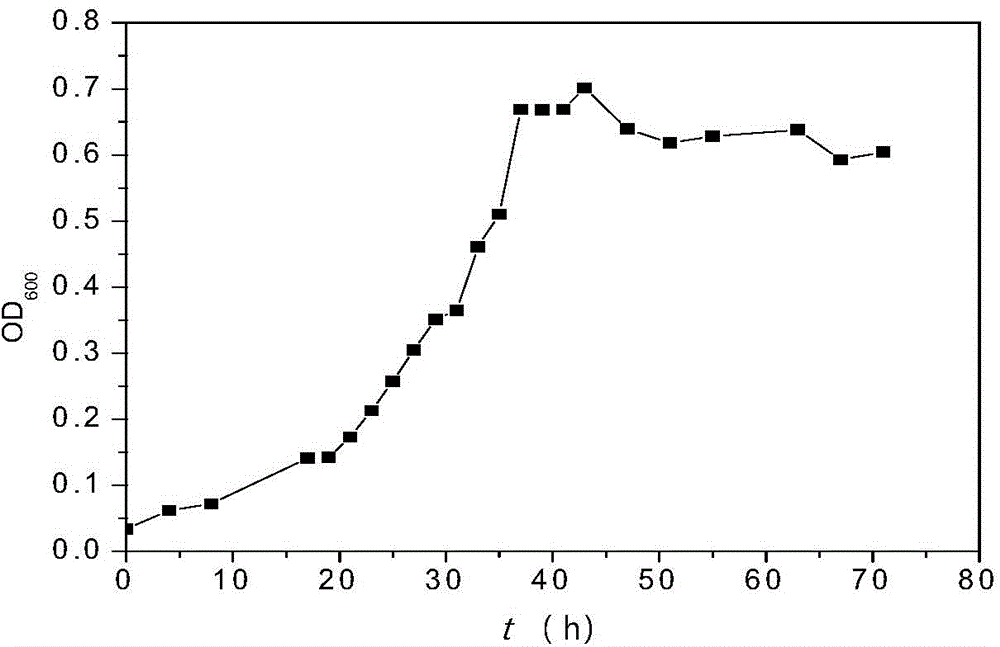Complex microbial inoculant for degradation of chlorohydrocarbon and application thereof
A compound bacterial agent and chlorinated hydrocarbon technology, applied in the field of microorganisms, can solve the problems of incomplete degradation and product toxicity, and achieve the effects of good adaptability, anti-pollution ability and good tolerance.
- Summary
- Abstract
- Description
- Claims
- Application Information
AI Technical Summary
Problems solved by technology
Method used
Image
Examples
Embodiment 1
[0047] Step 1) acclimatization of bacterial classification
[0048] Methylocystis sp.JTA1 directional domestication of chlorinated hydrocarbons: Garbage particles are selected from the mineralized waste of domestic waste landfills. This embodiment selects the Shanghai Laogang landfill (east of Laogang, Nanhui District, Shanghai) and has filled it. Buried garbage for 10 years, took garbage particles under 4mm sieve and 2mm sieve, added a certain amount of chloroform and adjusted the pH to be suitable for the growth of Methylocystis sp. Rejuvenation of the strain is achieved.
[0049] Methylobacterium sp.R1 chlorinated directional domestication: Garbage particles are selected from the overburden of domestic waste landfills. In this embodiment, Chongqing Changshengqiao Landfill (Nan'an District, Chongqing City) is selected, and the 4mm sieve and the 2mm sieve are taken. Garbage particles, add a certain amount of chloroform and adjust the pH to be suitable for the growth of Methy...
Embodiment 2
[0064] Embodiment 2: Composite bacteria agent is to the degradation of different concentrations trichlorethylene
[0065] 1. Take the composite bacterial agent (OD 600 =0.6±0.1) Put 20ml into a 100ml serum bottle, seal it with a polytetrafluoroethylene rubber stopper lined with it, and seal it with an aluminum cap, shake and culture at 30°C and 170r / min for 24h, and detect trichlorethylene by gas chromatography The degradation rate was 95%, which indicated that the composite bacterial agent had good trichlorethylene tolerance and degradation effect.
[0066] 2. Take the composite bacterial agent (OD 600 =0.6±0.1) Put 20ml into a 100ml serum bottle, seal it with a polytetrafluoroethylene rubber stopper lined with it, and seal it with an aluminum cap, shake and culture at 30°C and 170r / min for 24h, and detect trichlorethylene by gas chromatography The degradation rate was 96%, which indicated that the composite bacterial agent had good trichlorethylene tolerance and degradatio...
Embodiment 3
[0069] The histogram of the degradation of different concentrations of trichlorethylene by the compound bacterial agent is as follows figure 2 As shown, it shows that the composite bacterial agent has good tolerance and degradation effect under the condition that the concentration of trichlorethylene is less than 8mg / L, when the concentration of trichlorethylene is 1.65mg / L, 2.73mg / L and 5.39mg / L , the degradation rates reached 95%, 96% and 97% respectively. Example 3: Degradation of different types of chlorinated hydrocarbons in wastewater by composite bacterial agents
[0070] 1. Take the compound bacterial agent (OD 600 =0.6±0.1) Put 20ml into a 100ml serum bottle, seal it with a PTFE-lined rubber stopper, and seal it with an aluminum cap, shake and culture at 30°C and 170r / min for 6h, and detect with gas chromatography 1,3 - The degradation rate of trichloropropane is 0.03mg / (L*h), and the degradation rate reaches over 90% after 2 days of cultivation, indicating that th...
PUM
 Login to View More
Login to View More Abstract
Description
Claims
Application Information
 Login to View More
Login to View More - R&D
- Intellectual Property
- Life Sciences
- Materials
- Tech Scout
- Unparalleled Data Quality
- Higher Quality Content
- 60% Fewer Hallucinations
Browse by: Latest US Patents, China's latest patents, Technical Efficacy Thesaurus, Application Domain, Technology Topic, Popular Technical Reports.
© 2025 PatSnap. All rights reserved.Legal|Privacy policy|Modern Slavery Act Transparency Statement|Sitemap|About US| Contact US: help@patsnap.com



